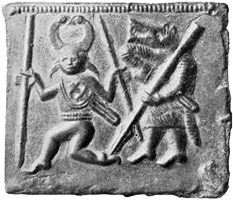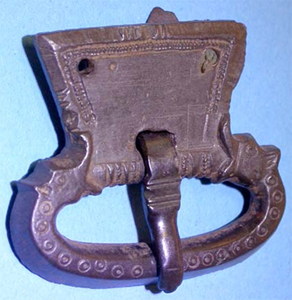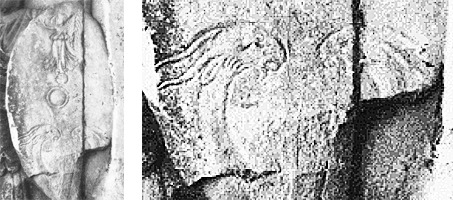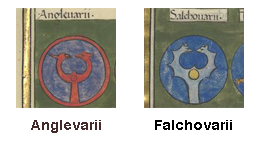
This page created 24 April 2014, and last modified: 12 November 2014 (Froben pattern added)

The Falchovarii is listed (12.33 in Ingo Maier's numbering scheme) as the 11th of 17 units of auxilia palatina under the command of the second Master of the Soldiers in the Imperial Presence ("Magister Militum Praesentalis II"). Its shield pattern (11#9) as shown in various manuscripts, under the matching label (11.i) Falchovarii, is as below:

The boss of the shield pattern is depicted as being yellow (with an internal yellow band in B); the main ground is indigo, rimless, and charged with a twin-headed zoomorphic motif that is common in the Notitia (well over a dozen examples), especially amongst auxilia palatina; the example borne by the Falchovarii is in blue, and somewhat more "spikey" than most (the closest example in shape is that labelled Exculcatores in the western half of the Notitia). The twin-headed zoomorphic device is not confined to the Notitia, however, but is known from a range of sources, especially in the north of Europe, such as on the ca. 6th century Torslunda bronze die from Sweden shown below:

More nearly contemporary with the Notitia is the late-Roman belt buckle shown below from Upavon, Wiltshire, England, in which the "animals" look more like dragons than anything else (other similar buckles frequently show stylised dolphins).

And dating to before the Notitia, from 315 at the latest, is this shield pattern depicted on the Arch of Constantine in Rome:

Below the winged Victory are two horned creatures, possibly goats, facing each other, and with their necks curving in towards each other (but interpreted by Michael P. Spiedel as dragons in "Ancient Germanic Warriors: Warrior styles from Trajan's Column to Icelandic sagas", Routledge, 2004); the bearer of the shield is frequently taken to be a member of the Constantine's Cornuti regiment (see here for more details).
The 11th unit under the command of the other Master of the Soldiers in the Imperial Presence, the Magister Militum Praesentalis I, is the Anglevarii; its shield pattern has the same indigo main ground as the shield shown for the Falchovarii, but adds a red rim, as is common to units in the first Magister's command; it also bears a twin-headed zoomorphic motif, albeit in red, and less "spikey". The two patterns are thus not dissimilar, as can be seen by comparing the versions taken from the Parisian manuscript:

These two units would thus appear to an example of formerly brigaded unit pairs that seem to have been split between the two Magistri. While in the command of the Magister Militum Praesentalis II, the Falchovarii were presumably brigaded with the next unit listed: the Thraces.
The name Anglevarii relates to the Germanic tribe the Anglii (as in "England" via i-mutation) who in Roman times lived in what is now southern Denmark. The name Falchovarii has likewise been interpreted as a tribal moniker, albeit an obscure one, originating from what is now Veluwe in the neighbouring Netherlands, meaning "unproductive", and related to the English word "fallow". However, others have seen in Falchovarii the word "falx" - i.e. sickle (and where English gets the word "falcon" from, due to the shape of the bird's bill), and so the exact provenance of the name is uncertain.

Return to the Notitia alphabetical unit list page.
Return to my Notitia index page.